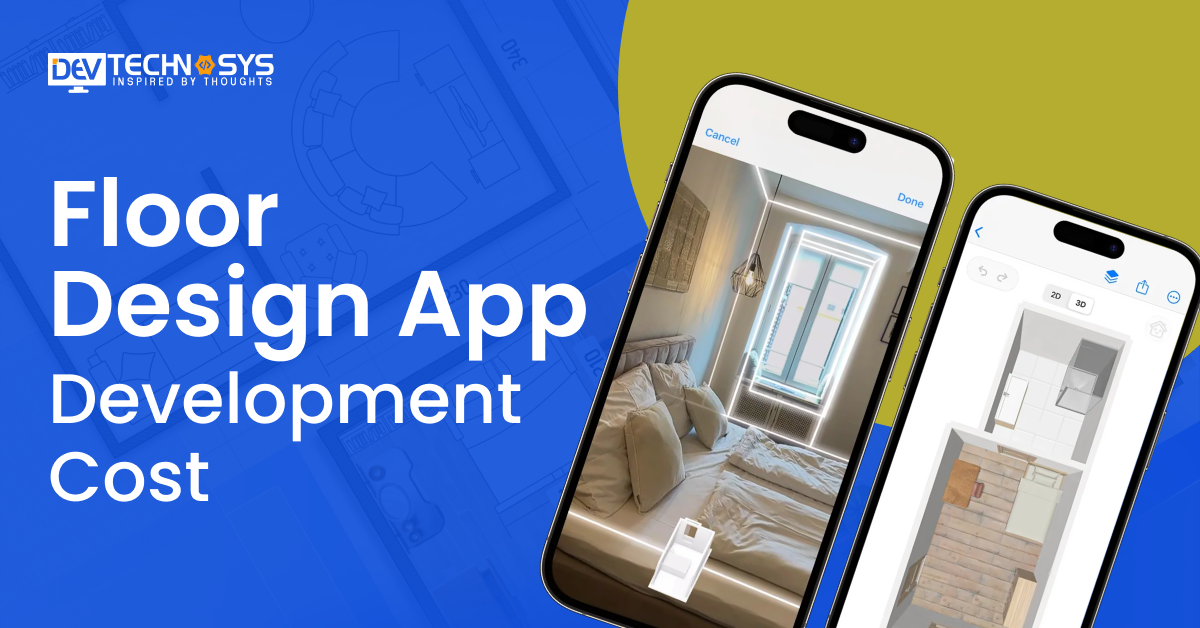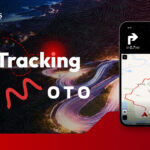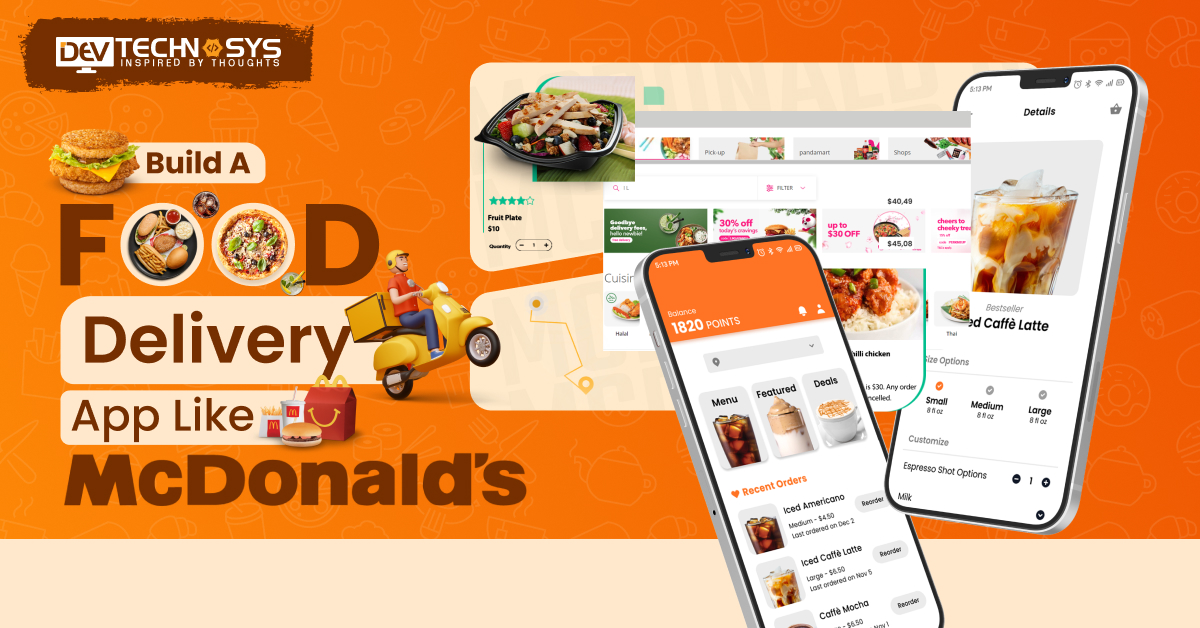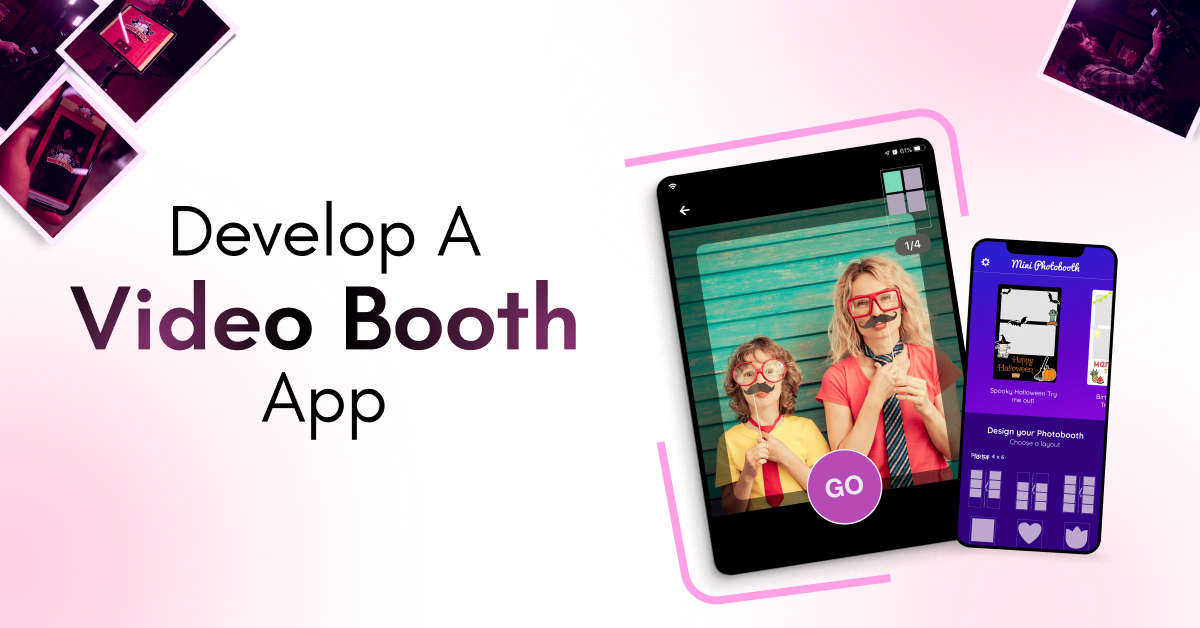“Modify your revenue growth by developing a floor designer application.”
“First Impression is the Last Impression.”
This quote is the perfect example of appearances that people deliver. It is a fact that bad flooring is not the part of modern homes. So, to make floor designing automated, flexible, and smart, various platforms are being developed. It is important for small and medium enterprises to know the right floor design app development cost, if they are looking to invest in the program.
There are several market-driven factors that influence the cost to make a floor design app at a large scale. Additionally, you must know app features, monetization techniques, and reducing methods to easily manage the budget.
Here, we will help you out to understand all these aspects in a detailed format with estimated pricing models for each cost affecting factor.
What are Floor Design Apps?
Using 2D and 3D modeling, floor design applications are digital tools that let users create, view, and alter architectural floor plans. The top software for interior design has drag-and-drop interfaces, AR/VR capabilities, and real-time collaboration. It is used extensively by architects, interior designers, and homeowners for space management, renovation, and layout planning.
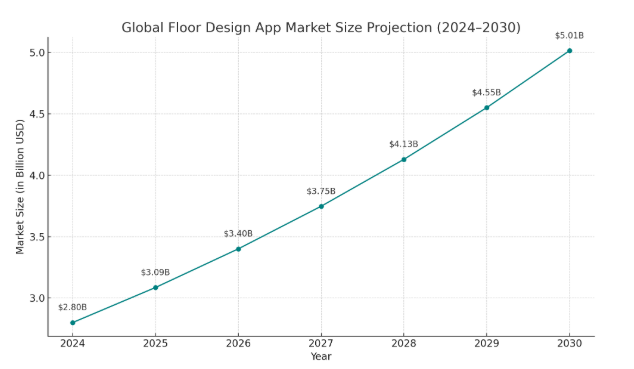
- The expected market size is valued at $2.8 Billion globally in 2024.
- And the projection of this industry is to reach $5.1 Billion at the end of 2030.
- The market is growing with an estimated rate of 2% CAGR between 2024 and 2030.
- North America Share: Accounts for over 35% of the global market revenue.
- Commercial Use Segment: Dominates with over 50% market share due to demand from construction and real estate.
- Mobile Platform Growth: Mobile-based floor design apps growing at 5% CAGR due to increased smartphone usage.
Benefits of Developing Floor Design Applications
You can develop a floor design app to give consumers and organizations a digital edge in floor design planning. These applications enhance user experiences, expedite processes, and provide revenue streams:
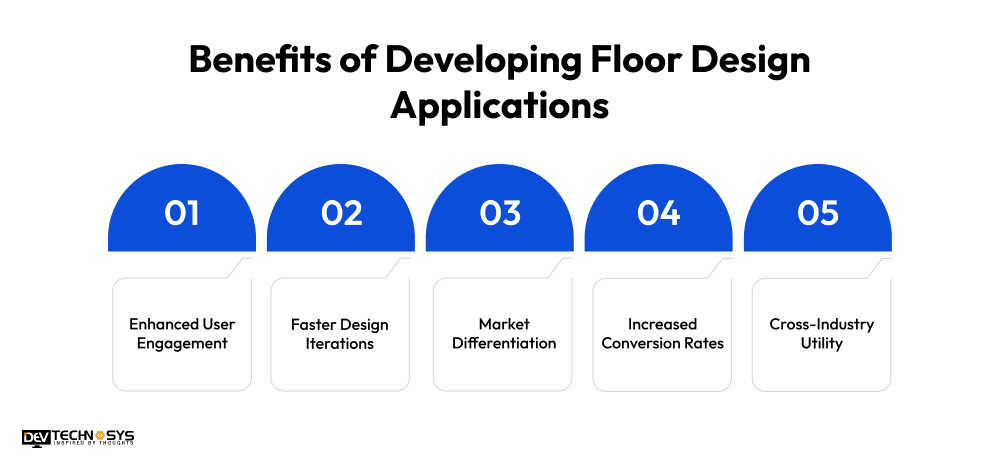
1. Enhanced User Engagement
Users are kept actively involved by interactive features including drag-and-drop, 3D views, and real-time editing. Users spend more time in the app because of its user-friendly controls and personalized design recommendations. Increased engagement increases user retention and satisfaction.
2. Faster Design Iterations
With digital tools, changes can be made quickly without starting from scratch or redrawing. Instantaneous layout testing allows users to shorten the time between concept and finished design. For both professionals and people, use of Android app development services speeds up project timelines.
3. Market Differentiation
In the construction, interior design, and real estate industries, a personalized floor design app makes brands stand out. Including cutting-edge technologies like augmented reality or teamwork tools increases the cost to develop a floor design app. It presents your company as creative and customer-focused.
4. Increased Conversion Rates
Users can make decisions more quickly and confidently with the use of visualization tools. Improved design clarity results in fewer modifications and quicker approvals. A floor design app development company may help to get higher conversion rates for sales or service reservations.
5. Cross-Industry Utility
These applications cater to a number of industries, including retail furniture, real estate, architecture, and home remodeling. They can be modified to meet specific industry use cases. Greater monetization and collaboration opportunities result from broader application.
Use of AI in Floor Design App Development
The creation of floor design apps is being revolutionized by AI, which makes intelligent automation, accuracy, and customized experiences possible. An iPhone app development company helps to improve the effectiveness and originality of the design process in a variety of ways, from creating layouts to optimizing space and user preferences.
Additionally, it reduces the cost to build a floor design app and facilitates real-time analysis, saving professionals and end users alike time and effort.
- Automated Layout Generation: Instantly creates optimized floor plans based on user input and space constraints.
- Space Optimization: Analyzes room dimensions and suggests the most efficient furniture placement.
- Style and Design Recommendations: Offers interior design suggestions based on user preferences and trends.
- 3D Visualization Enhancements: Improves rendering realism with AI-driven lighting and texture effects.
- Error Detection: Identifies design flaws or spacing issues in real-time for better accuracy.
What is the Floor Design App Development Cost?
A number of technical, commercial, and operational considerations influence the floor design app development cost. These factors affect the overall resource allocation and project scope. Making strategic development decisions and creating an accurate budget require an understanding of them:
1. Demographic Changes
User expectations vary by country, for example, users in the US can choose advanced augmented reality, whereas users in emerging economies might prefer offline, lightweight apps. Design and localization expenses may increase the mobile application development cost based on regional preferences.
| Demographic Changes | Estimated Cost |
| USA | $25000-$30000 |
| Australia | $20000-$25000 |
| India | $5000-$12000 |
| UK | $15000-$20000 |
| UAE | $8000-$15000 |
| Brazil | $12000-$16000 |
2. App Complexity
The floor design app development cost is greatly increased by advanced capabilities like 3D rendering and AR integration. It takes more work and testing to add more screens, logic layers, and interactions. A professional-grade platform with many features may be significantly more expensive than a basic app.
| App Complexity | Development Time | Estimated Cost |
| Simple | 2-5 months | $5000-$10000 |
| Moderate | 5-8 months | $10000-$15000 |
| Complex | 8-12 months | $15000-$20000 |
| Premium | More than 12 months | $20000-$25000 |
3. Experience Level
The cost to develop a floor design app will arise from hiring developers or designers with extensive experience. Skilled teams frequently generate higher-quality code and operate more effectively. Error correction and long-term maintenance expenses can be decreased by investing in experience.
| Experience Level | Cost Estimation |
| Junior/Entry-Level | $8000-$12000 |
| Mid-Level/Experienced | $12000-$16000 |
| Senior/Expert | $16000-$20000 |
| Professional | $20000-$24000 |
4. Hiring Model
Whether you choose to hire someone in-house, engage a freelancer, or contract with an agency will affect the cost to build a floor design app. Because of salary, equipment, and perks, in-house teams may be more expensive. Outsourcing and freelancers provide flexibility and a smaller initial outlay.
| Hiring Model | Estimated Cost |
| In House Team | $5,000-$8,000 |
| Full-Time Freelancers | $3,500-$5,000 |
| Developer Outreach | $8,000-$15,000 |
5. Platform Choice
The overall cost is impacted by developing for iOS, Android, the web, or all platforms. Compared to creating distinct native apps, cross-platform development is more cost-effective. Additionally, you may contact an Android app development company to understand UI, compliance, and testing criteria.
| Platform Choice | Estimated Cost |
| Native App | $10,000-$15,000 |
| Flutter App | $15,000-$18,000 |
| Hybrid App | $18,000-$20,000 |
6. Technical Cost
Third-party APIs, cloud services, 3D engines, and design tools are among the costs. Advanced features like CAD integration or AR modules may come with hefty licensing costs. Decisions about the tech stack have an immediate effect on both initial and ongoing cost to create a floor design app.
| Technical Cost | Estimated Cost |
| Artificial Intelligence | $10,000-$15,000 |
| Blockchain | $15,000-$20,000 |
| Cloud Computing | $20,000-$25,000 |
| IoT Integration | $25,000-$30,000 |
7. Security Charges
Strong encryption and compliance are necessary for protecting user data, designs, and financial transactions. The time and expense of development are increased by implementing SSL, GDPR, and user authentication. Higher long-term risks and liabilities can result from security neglect.
| Component | Description | Estimated Cost |
| Data Encryption (SSL/TLS) | Secures data transmission between client and server | $500 – $1,000 (one-time) |
| Authentication Systems | User login, OTP, biometrics, or social logins | $1,000 – $3,000 |
| Compliance Implementation | GDPR, HIPAA, or similar regulatory compliance | $2,000 – $5,000 |
8. Frontend Development
It requires effort and expertise to create a user interface that is responsive and intuitive with features like drag-and-drop functionality or fluid animations. The cost and design testing needs rise with the number of screens. Performance and aesthetic appeal across devices must be balanced by the front-end.
| Component | Description | Estimated Cost |
| UI/UX Design | Wireframes, prototyping, design assets | $2,000 – $5,000 |
| 2D/3D View Implementation | Visual render of floor plans in 2D/3D | $4,000 – $10,000 |
| Drag-and-Drop Interface | Interactive design editor for layout creation | $3,000 – $6,000 |
9. Backend Integration
Backend services provide real-time synchronization, cloud storage, user accounts, and more. The cost and complexity of servers are impacted by integration with databases, APIs, and mobile app maintenance services. The development budget must include a scalable, secure backend.
| Component | Description | Estimated Cost |
| User Authentication & Profiles | Secure account creation and user data storage | $1,000 – $3,000 |
| Database Integration | Storing design files, user data, object libraries | $2,000 – $5,000 |
| Real-Time Collaboration | Multi-user editing, syncing changes in real time | $3,000 – $7,000 |
| Cloud Storage Integration | Saving designs on cloud platforms (AWS, Firebase, etc.) | $1,500 – $4,000 |
10. Work Flexibility
Development work is increased by flexible features like cross-device capabilities, cloud syncing, and offline access. They necessitate extensive preparation and testing, but these choices improve user experience. The associated cost to make a floor design app increases with its degree of adaptability.
| Component | Description | Estimated Cost |
| Offline Access | Local storage and sync capabilities for offline usage | $2,000 – $5,000 |
| Multi-Device Sync | Seamless updates across devices (mobile, tablet, web) | $3,000 – $6,000 |
| Cross-Platform Functionality | Consistent behavior across iOS, Android, and web platforms | $4,000 – $8,000 |
How to Reduce the Rate of Developing Floor Design Apps?
For new companies and enterprises striving for efficiency, lowering the floor design app development cost is essential. Here are seven clever ways to reduce expenses without sacrificing the quality of the app:
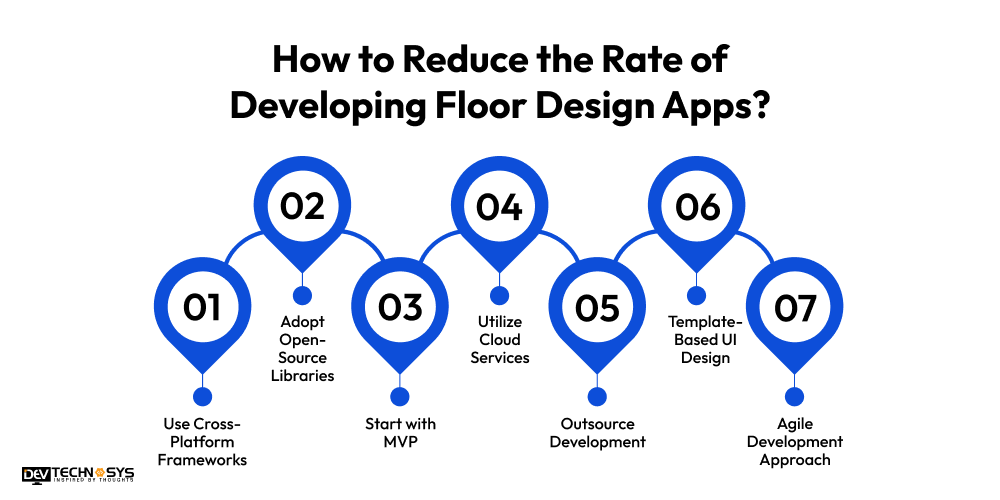
1. Use Cross-Platform Frameworks
It is possible to build a single codebase for several platforms by using frameworks such as Flutter, React Native, or Unity. As a result, fewer teams are required for iOS, Android, and the web. It guarantees consistent performance while drastically cutting down the cost for floor design app development.
2. Adopt Open-Source Libraries
Development is accelerated by utilizing open-source CAD libraries, UI elements, and 2D/3D engines. It removes the necessity of creating intricate features from the ground up. A mobile app development company may help you to use these libraries to save money and effort.
3. Start with MVP
Create a Minimum Viable Product (MVP), concentrating mainly on essential aspects such as 2D/3D view and layout design. This enables progressive feature extension, genuine user input, and a quicker launch. It assists in preventing initial floor design app development cost due to premium features.
4. Utilize Cloud Services
For scalable backend and storage, use cloud services like AWS, Google Cloud, or Firebase. This makes maintenance easier and eliminates the need for expensive on-premises infrastructure. Businesses can hire dedicated developers that guarantees cost effectiveness and flexibility in response to app expansion.
5. Outsource Development
Employ teams or developers with experience from more affordable areas like South Asia or Eastern Europe. Without compromising quality, outsourcing may decrease the cost to build a floor design app. Select a trustworthy company or independent contractors with design or architectural app knowledge.
6. Template-Based UI Design
For quicker design, make use of component libraries and existing UI templates within the mobile application development process. Templates cut down on design time and eliminate the need for expensive UI/UX experts. They also give the app a professional, unified appearance.
7. Agile Development Approach
Prioritize features and divide the project into manageable sprints. Agile development enables flexible scope modifications, user feedback, and ongoing testing. This method guarantees effective use of resources and reduces the cost to develop a floor design app.
Key Features of Floor Design Applications
Applications for floor design are loaded with strong features that improve usability and functionality. These tools make it easier to create, visualize, and share layouts easily:
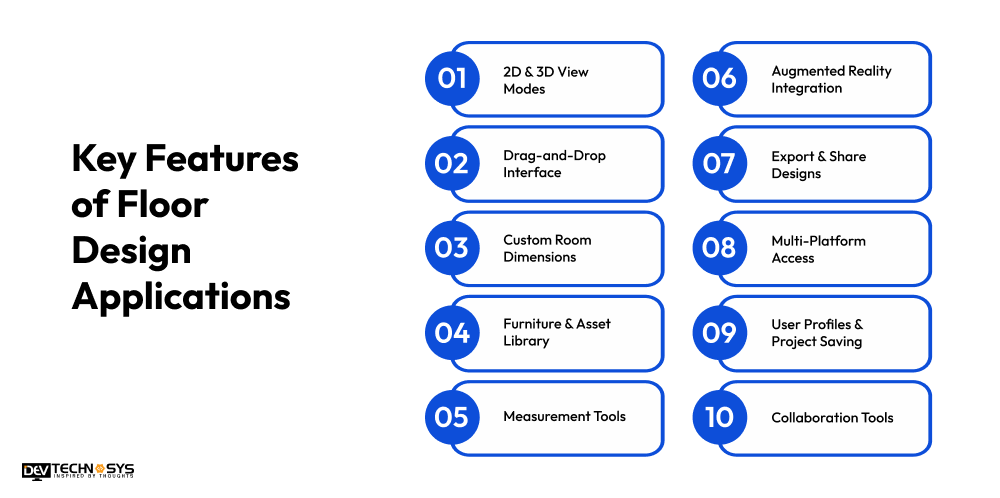
1. 2D & 3D View Modes
Allows users to switch between flat layouts and immersive 3D visualizations. Helps in better understanding of spatial arrangements and interior design flow.
2. Drag-and-Drop Interface
Various apps to design floor plans enable easy placement and rearrangement of walls, furniture, and objects. Reduces design time and simplifies the planning process for all user levels.
3. Custom Room Dimensions
Users can input exact measurements for walls and rooms. You can develop an app like Room Planner that ensures designs are scalable and suitable for real-world execution.
4. Furniture & Asset Library
Provides a collection of furniture, decor, and fixtures to use in designs. Enhances creativity and gives realistic visualization of interior spaces.
5. Measurement Tools
Includes rulers, grid snapping, and auto-measurements for precise planning. To improve accuracy and avoid design errors, you can build a floor design app.
6. Augmented Reality Integration
The best floor design app lets users visualize designs in their real environment using AR technology. Bridges the gap between digital planning and physical space preview.
7. Export & Share Designs
A floor plan design app supports exporting floor plans in formats like PNG, PDF, or CAD files. Users can easily share projects with clients, collaborators, or social platforms.
8. Multi-Platform Access
A flooring design app allows access via web, mobile, and desktop platforms. Ensures users can design and edit projects anytime, anywhere.
9. User Profiles & Project Saving
This enables saving multiple designs under one account with cloud backup. The best home interior design software supports continuity and easy retrieval of previous projects.
10. Collaboration Tools
Allows multiple users to work on the same project simultaneously. Facilitates real-time feedback, edits, and teamwork for design professionals.
Top 10 Floor Design Applications
For architects, interior designers, and real estate agents, floor design programs have become useful resources. These apps have smart customizing tools, AR/VR compatibility, 2D/3D modeling, and user-friendly interfaces.
The correct floor design app simplifies space planning with precision and originality, whether it is for remodeling or layout visualization:
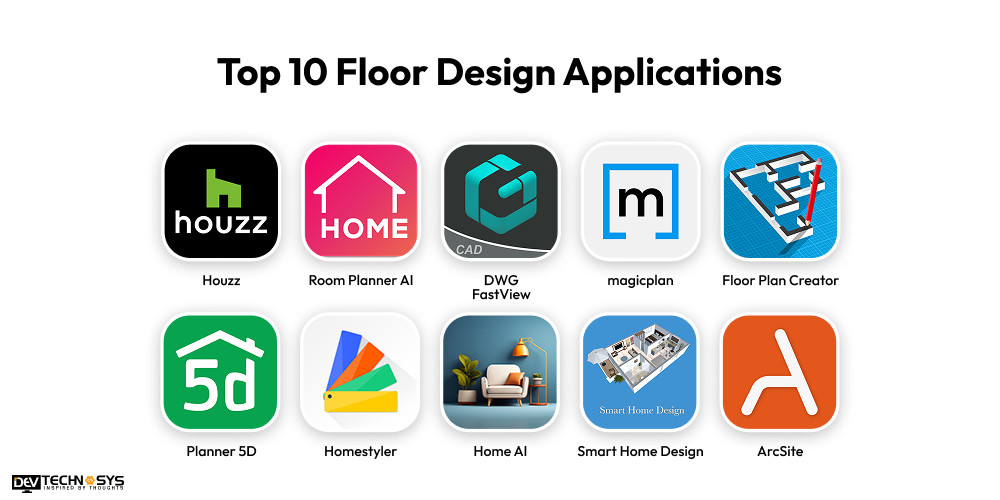
| Top 10 Floor Design Applications | Supported Devices | Downloads | Ratings |
| Houzz | Android|iOS | 10M+ | 4.5 |
| Room Planner AI | Android|iOS | 10M+ | 4.5 |
| DWG FastView | Android|iOS | 10M+ | 4.4 |
| magicplan | Android|iOS | 10M+ | 4.3 |
| Floor Plan Creator | Android|iOS | 10M+ | 4.2 |
| Planner 5D | Android|iOS | 10M+ | 4.0 |
| Homestyler | Android|iOS | 10M+ | 3.8 |
| Home AI | Android|iOS | 5M+ | 4.3 |
| Smart Home Design | Android|iOS | 1M+ | 4.4 |
| ArcSite | Android|iOS | 100K+ | 4.4 |
Major Challenges in Developing Floor Design Applications
Complex technological and design issues arise while creating floor design applications. It takes proper planning and advanced development abilities to guarantee accuracy, performance, and usability:
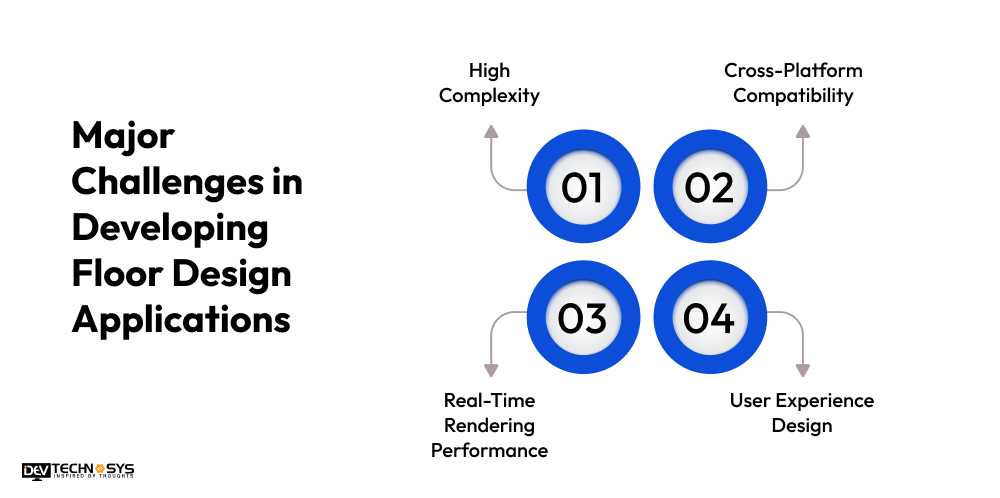
1. High Complexity
Advanced geometry, spatial algorithms, and 2D/3D modeling are all used in floor planning. The process to create a floor design app becomes more challenging when precise measurements are required.
Solution: Use pre-built geometry libraries and CAD APIs to expedite development and guarantee accuracy.
2. Cross-Platform Compatibility
Consumers anticipate consistent desktop, iOS, Android, and online performance. A strong cross-platform tech stack is necessary to preserve feature parity and design consistency.
Solution: For consistent app functionality, hire mobile app developers to use cross-platform frameworks such as Unity, React Native, or Flutter.
3. Real-Time Rendering Performance
Real-time rendering of 3D models and visuals requires a large amount of computer power. Speed optimization without compromising visual quality is a never-ending technical problem.
Solution: To improve rendering, use level-of-detail (LOD), lazy loading, and GPU acceleration.
4. User Experience Design
For a variety of user groups, striking a balance between sophisticated functionality and usability is essential. Users can be rapidly turned off by a confusing UI or a high learning curve.
Solution: Use tutorials, tooltips, and simple drag-and-drop tools to create a mobile app and increase user engagement.
How to Monetize Apps for Floor Designing?
Effective floor design app monetization guarantees sustainability and long-term income. App developers can use these six tried-and-true methods to make money from floor design platforms:
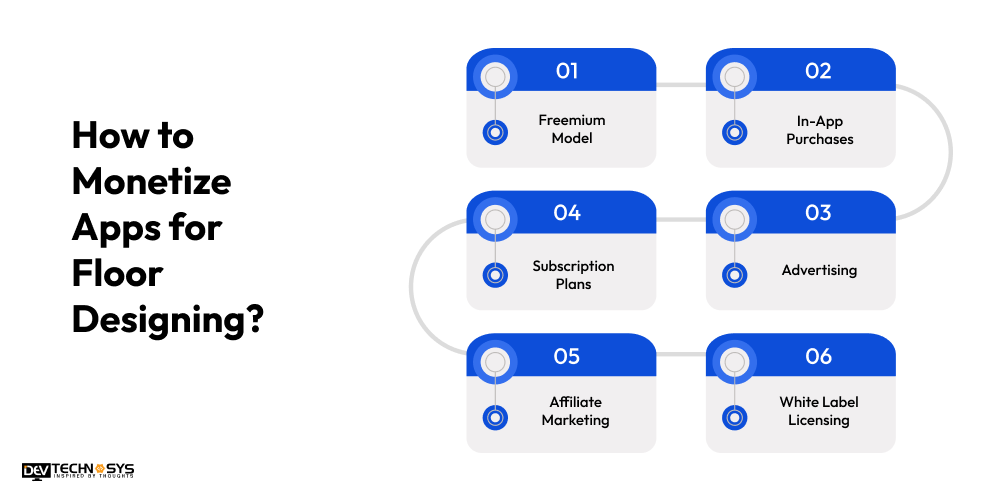
1. Freemium Model
To draw in a large user base, provide a free version with restricted functionality. A premium tier is required to access advanced features including 3D rendering, HD exporting, and augmented reality capabilities. This model maintains the app’s accessibility while promoting updates.
2. In-App Purchases
Sell extras like furniture models, texturing, or high-quality templates. When necessary, users can purchase digital assets to expand their design options. You can build an AI interior design app that provides adjustable features under this strategy according to personal tastes and needs.
3. Subscription Plans
You should make a floor design app with premium features available through monthly or annual payments. Priority support, cloud storage, collaborative tools, and special tools are all provided to subscribers. Over time, recurring revenue aids in app maintenance and enhancement.
4. Advertising
Include interstitials, banner advertisements, or rewarded video commercials in the free edition. Ad impressions and user interactions are the basis for revenue generation. To preserve a positive user experience, make sure advertisements are not invasive.
5. Affiliate Marketing
Collaborate with companies that sell buildings, furnishings, or décor, and advertise their goods on the app. Get paid when customers use top AI interior design apps to make purchases or click on links. By connecting design concepts with practical purchasing alternatives, this offers value.
6. White Label Licensing
Give other companies or design firms licenses to use the app under their own names. While developers receive licensing fees, they receive a platform that can be customized. Opportunities for recurrent and scalable revenue are provided by this B2B business.
Let’s Summarize!!
Now, you can easily balance the floor design app development cost with the above listed monetization methods. Additionally, it will be easy for modern investors like you to hire a reliable and experienced IT consulting company for availing various mobile app development services. But, it is important to list target audiences to deliver specific and user-centric features.
Additionally, entrepreneurs must examine different business models that are making huge revenue through delivery of AI-powered app features. Above all, you need to reduce the cost to create a floor design app by keeping a flexible budget. Doing all this, may lead to a consistent business growth and revenue generation.
FAQs
Q1. Which Floor Design Apps are Popular in the USA?
Planner 5D, RoomSketcher, HomeByMe, SketchUp, and MagicPlan are some of the most widely used floor design applications in the United States. These applications include sophisticated 2D/3D visualization tools together with intuitive user interfaces.
Q2. What is the Maintenance Cost of Floor Design Apps?
Depending on the size and complexity of the software, maintenance expenses usually run from $500 to $2,000 each month. Updates, bug patches, server hosting, and customer service are all included in the price.
Q3. How Long Does it Take for Floor Design App Development?
A simple floor design software takes 3 to 6 months to develop. It could take 6 to 12 months or longer for feature-rich apps with cloud syncing, 3D rendering, and augmented reality. The tech stack, team size, and complexity all affect the timeline.
Q4. What Tech Stack is Used for Developing Floor Design Applications?
- Frontend Technologies: HTML5, CSS3, JavaScript, and frameworks like React.
- Backend Technologies: Node.js, Python, or Ruby with databases like MongoDB.
- 3D/AR Integration: Three.js, WebGL, Unity3D, or ARKit/ARCore.
Q5. How Much Does it Cost to Hire Floor Design App Developers?
Depending on the area and level of experience, hiring developers can cost anything from $10 to $80 per hour. Depending on its features and extent, a whole app creation could cost anywhere from $8,000 to $30,000 or more. With offshore developers, costs are reduced, but quality and communication may suffer.
Q6. Are Floor Design Apps Free to Use?
Basic versions of several floor design software are available for free. Paid plans or in-app purchases are frequently necessary for premium services like HD exporting, sophisticated 3D modeling, and AR compatibility. A freemium business model is used by certain apps, enabling users to upgrade as needed.
